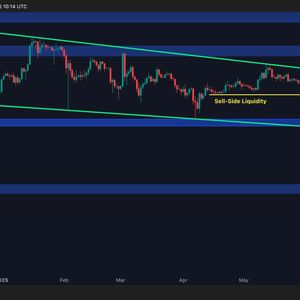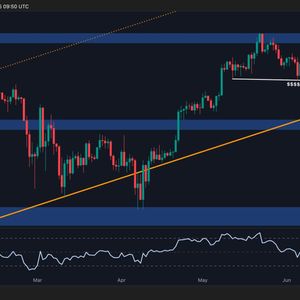In a landscape where every economic indicator is scrutinized for clues about the future of finance, Federal Reserve Bank of Philadelphia President Patrick Harker’s recent remarks offer a beacon of calm. Speaking on Monday, February 17, 2025, Harker suggested that the current economic climate supports maintaining a steady Fed rate policy for now. This statement, reported by Reuters, arrives as the crypto market closely monitors traditional finance for signals that could influence digital asset valuations, particularly concerning the strength of the US Dollar . Decoding Harker’s Stance on Interest Rates Harker’s comments provide a clear snapshot of the Fed’s current thinking. Let’s break down the key takeaways from his address: “Monetary policy is in a good place right now.” This suggests a level of satisfaction within the Fed regarding their current stance. It implies that the existing interest rates are effectively navigating the economic currents. “Future Fed rate policy choices will be data-driven.” Harker emphasizes the Fed’s reliance on economic data to guide future decisions. This data-dependent approach means that upcoming economic reports will be critical in shaping expectations around interest rate adjustments. “Fed policy stance should continue to lower inflation.” Despite acknowledging that inflation remains elevated, Harker expresses confidence that the current policy trajectory is geared towards bringing inflation back to the desired target. “Inflation elevated and has been sticky over recent months.” This acknowledgment of persistent inflation highlights the ongoing challenge for the Fed. While progress has been made, the ‘stickiness’ suggests the final mile to the 2% target might be the toughest. “Inflation seen back to 2% target over the next two years.” This provides a timeline for the Fed’s inflation target. It suggests a patient approach, indicating no immediate urgency for drastic policy shifts, reinforcing the idea of a steady Fed rate policy . “Labor market is largely in balance.” A balanced labor market is a positive sign, suggesting healthy economic activity without excessive inflationary pressure from wage growth. “The economy is functioning from a position of strength.” This is a robust assessment, indicating underlying resilience in the US economy, which allows for a more measured approach to monetary policy . “Unsure what impact new government policies will have on the economy.” Harker expresses uncertainty about future fiscal policy impacts, a factor that the Fed will undoubtedly monitor as it formulates its monetary policy going forward. The Fed’s Mandate: Price Stability and Full Employment To truly grasp the significance of Harker’s statements, it’s essential to understand the Federal Reserve’s dual mandate: to maintain price stability and foster full employment. These two goals often require a delicate balancing act, especially when managing interest rates . The Fed’s primary tool to achieve these mandates is adjusting interest rates . Here’s how it works: Combating Inflation: When inflation surges above the Fed’s 2% target, they typically raise interest rates . This makes borrowing more expensive, cooling down economic activity and, in turn, curbing inflation . Higher interest rates also tend to strengthen the US Dollar , as it becomes more attractive for international investors to hold USD-denominated assets. Supporting Employment: Conversely, if inflation falls too low or unemployment rises excessively, the Fed might lower interest rates to encourage borrowing and stimulate economic growth. Lower interest rates can put downward pressure on the US Dollar . Monetary Policy Tools Beyond Interest Rates While interest rates are the Fed’s primary lever, they also employ other tools, particularly in extraordinary economic circumstances: Quantitative Easing (QE) During crises, like the 2008 Great Financial Crisis, the Fed may resort to Quantitative Easing (QE). QE involves the Fed injecting liquidity into the financial system by purchasing assets, such as government bonds, on a large scale. This action aims to lower long-term interest rates and stimulate the economy when short-term rates are already near zero. QE typically dilutes the value of the US Dollar . Quantitative Tightening (QT) Quantitative Tightening (QT) is the opposite of QE. It’s the process of unwinding the Fed’s balance sheet by reducing its holdings of bonds. This is done by either selling bonds or by not reinvesting the proceeds when bonds mature. QT is generally seen as a measure to tighten monetary policy and is usually supportive of the US Dollar ‘s value. Impact on the Crypto Market and Beyond For cryptocurrency investors, understanding the nuances of Fed rate policy is crucial. A steady rate policy, as suggested by Harker, can be interpreted as a sign of economic stability, which can be beneficial for risk assets like cryptocurrencies. However, the crypto market also reacts to US Dollar strength. A consistently strong dollar, often a byproduct of higher interest rates (though not in this steady rate scenario), can sometimes temper enthusiasm for crypto as investors may prefer the relative safety of USD-denominated assets. Conversely, periods of anticipated rate cuts or QE can weaken the US Dollar and potentially drive investors towards alternative assets like Bitcoin and other cryptocurrencies as hedges against inflation or dollar devaluation. Therefore, while Harker’s steady rate outlook suggests near-term stability, the crypto market will remain keenly attuned to future Fed communications and economic data releases that could hint at shifts in monetary policy . Conclusion: Navigating the Steady Course Patrick Harker’s remarks offer a valuable insight into the Fed’s current perspective. The emphasis on a steady Fed rate policy reflects a belief that the US economy is on a stable path, with inflation expected to gradually return to the 2% target. For investors in all markets, including cryptocurrencies, this suggests a period of watchful waiting. The focus now shifts to upcoming economic data and further Fed pronouncements that will either reinforce this steady course or signal a change in direction. Staying informed and adaptable remains key in these ever-evolving economic waters. To learn more about the latest Forex market trends, explore our article on key developments shaping US Dollar interest rates and liquidity.



















